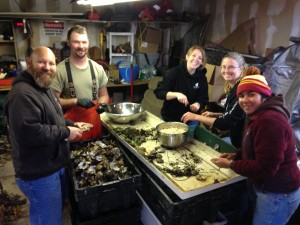Diana Chin and Will Wied are continuing the Peterson lab tradition of tying many small animals to stakes and staples in the sand to see if anything will eat them … in Panama!
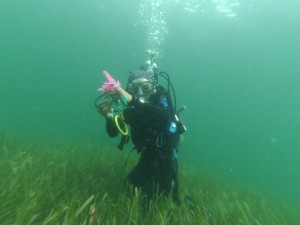
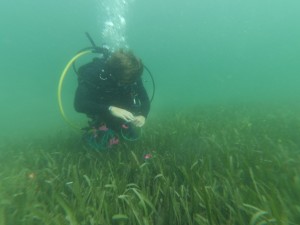
Diana Chin and Will Wied are continuing the Peterson lab tradition of tying many small animals to stakes and staples in the sand to see if anything will eat them … in Panama!


The Peterson Marine Community Ecology Lab is seeking to interview and select six to eight (6 – 8) highly motivated volunteer research assistants this summer to work on several dissertation and monitoring projects (for a partial list of projects, see below). Research hours can be used towards research credit hours with Dr. Bradley Peterson.
Volunteers will be asked to commit at least two days per week (preferably consecutive days) from June through August. Exact starting and end dates are negotiable.
***We are also seeking one person who would be able to work intensively with Amanda Tinoco on a specific project (examining the effects of predator acoustic cues on mud crab consumption of blue mussels) five days per week for the month of June.
We specifically look for people who are comfortable and enjoy being outdoors, especially in the field on boats and in the water. Volunteers should be in good physical shape and enjoy hands-on work. Ability to swim is a requirement.
If interested, please send your CV/resume, research interests, and a list of available meeting times to Diana Chin, diana.chin@stonybrook.edu. Alternatively, feel free to contact a lab member regarding a specific project listed below. (Please note that with the exception of Amanda’s experiments in June, it is unlikely that you will work exclusively on one project. Our philosophy is that exploring a variety of research questions and methods is essential to your scientific development!)
Summer Projects:
Contact: Rebecca Kulp, rkulp1@gmail.com
I will be looking at how prey mobility affects foraging efficiency of crustacean mesopredators across varying habitat types and densities. Prey preference between mobile and sessile prey will also be evaluated using consumption rate, handling time, and encounter rate.
Contact: Diana Chin, diana.chin@stonybrook.edu
This summer’s research will involve a field experiment to evaluate whether the commensal relationship between seagrass and a species of chemosymbiotic clam (which “eats” sulfide in sediment) changes across a gradient of light exposure to the seagrass. I will also be using field tethering experiments to look at whether seagrass can provide a predation refuge for the clam.
In addition, I’m looking for someone who wants to come to Panama in fall 2016 to do tropical clam and seagrass research!
Contact: Steve Heck, heck.stephen@gmail.com
This summer, I plan on looking into how several species of larger fish predators influence community structure in seagrass ecosystems. More specifically, I aim to look at how larger fish predators govern the feeding activity and abundance of crustacean mesopredators that prey on bay scallops and how this influences the survival of these bivalves. This will involve a combination of field and mesocosm experiments.
Contact: Amanda Tinoco, amandaisabeltinoco@gmail.com
My research will focus on the effects of predator acoustic cues on the foraging behavior of mud crabs on blue mussels. Work will consist of helping set up and break down mesocosm experiments as well as going out in the field to collect organisms for my experiments. This work will be primarily completed during the month of June.
Other Monitoring and Research:
Beyond the projects above, the lab will be conducting water quality assessments in Jamaica Bay, Great South Bay, Shinnecock Bay, and Peconic Bay; hard clam condition assessments for Great South Bay; and a shellfish-based restoration project in Great South Bay.
It’s that time of year! The Peterson Lab (Brad, four current graduate students, three lab alumni, and three current or former undergraduates) recently attended the 2016 Benthic Ecology Meeting in Portland, ME. As always, there was much science, dancing, and general merriment as we reconnected with old friends and dove into the latest news from our colleagues in all areas of benthic marine ecology.
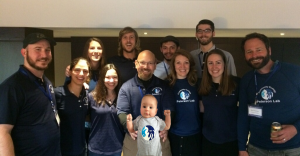
A special feature this year was a session of talks organized by Brad and given by scientists who have all been mentored as interns, master’s students, PhD students, or postdocs by Dr. Ken Heck of Dauphin Island Sea Lab, who was Brad’s PhD advisor.
Here’s a list of our posters and presentations from this year’s Benthics:
Cashin M.J.; Kulp, R.E.; Peterson, B.J. Preference in prey type and size of Crepidula fornicataand Mytilus edulis by the mesopredator Dyspanopeus sayi. (poster)
Chin, D.W.; Peterson, B.J. A commensalism between awning clams (Solemya velum) and eelgrass (Zostera marina) mediated by sulfideoxidizing bacteria.
Floros, N.J.; Kulp, R.E.; Peterson, B.J. Evaluating effects of habitat type on foraging efficiency.
Furman, B.T.; Hall, M.O.; Merello, M.; Durako, M.J. Field notes on the recurrence of Thalassia testudinum dieoff in Florida Bay.
Heck, S.M.; Tinoco, A.I.; Peterson, B.J. Exploring how a suite of predators influences the vertical spatial distribution & survival of bay scallops.
Kulp, R.E; Peterson, B.J. Comparing functional response curves across a structural density gradient with increasing intraspecific competition.
Peterson, B.J. “All I want to do is HIDE around, Sally”: Ken’s evolving thoughts on habitat complexity and species diversity.
Stubler, A.D.; Peterson, B.J. Ocean acidification accelerates dissolution and bioerosion in a coral rubble community.
Tinoco, A.I.; Heck, S.M; Peterson, B.J. Effects of Hurricane Sandy on Great South Bay, Long Island: Assessing water quality, seagrass and nekton communities.
Vlasak, T.J.; Kulp, R.E.; Peterson, B.J. Comparing the survivorship of Dyspanopeus sayi in slipper snail and seagrass beds in Shinnecock Bay, New York. (poster)
The Peterson Lab has been pretty busy this summer season, here is an update on all of the different projects that we have been working on!
Diana Chin continues to run experiments looking at a potential mutualism between eelgrass and Solemya velum (a clam with symbiotic sulfur-oxidizing bacteria in its gills). She would be really happy if she could figure out who their predators are in the field and if she could get them to spawn successfully in the lab. She has also been running the Long Island branch of the ZEN (Zostera Experimental Network) collaboration, which this summer included a large caging experiment, blue carbon sediment cores, and mesopredator surveys.

Rebecca Kulp has spent her summer hard at work understanding relationships between habitat complexity and predator-prey interactions using mud crabs and mussels. She focused on predator foraging efficiency by changing both the habitat structure density and level of competition.

Stephen Heck has been researching the effects of the presence of porgy on the consumptive rates of mud crabs on bay scallops as well as how the presence of the two predators influence the vertical distribution of bay scallops in the eelgrass canopy.

Amanda Tinoco has been working on some of the NPS projects in Great South Bay, helping runt he water quality and nekton monitoring programs. She also has been setting up a mesocosom experiment to study the effect of acoustic signals on predator consumptions, particularly examining how the sound of a predator (blue crab) eating it’s prey (mud crab) can affect the foraging behavior of mud crabs in different habitats.
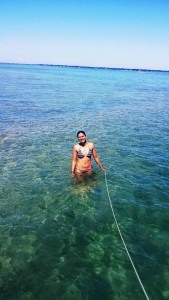
Amber Stubler has been leading nekton survey dives on artificial off-shore reefs and keeping the lab healthy.
Brad Peterson has been working with all the students and making sure the Peterson lab is producing awesome research. He even prepared for his Hollywood career debut when the NPS came out to Great South Bay to check out what the lab does and interview the Peterson himself.

Professor Bradley Peterson’s past graduate students, Jamie Brisbin, is now an Air Force Pararescue looking for the downed helicopter in Nepal.
Best of luck to Jamie!
NOW in Nepal | @usairforce Pararescuemen (PJs) with @PACAF flying search & rescue missions with @USMC to find helo. pic.twitter.com/FigVLpG9ZV
— 3d MEB (@3d_MEB) May 13, 2015
https://www.dvidshub.net/image/1929963/search-and-rescue-find-missing-aircraft-nepal#.VVTBa_lVhBc
The Peterson Lab had a strong showing at the 2015 Benthic Ecology Meeting in Quebec City, Canada! Brad Peterson, six current graduate students, one undergraduate student, and two Peterson Lab alumni were in attendance at the conference.
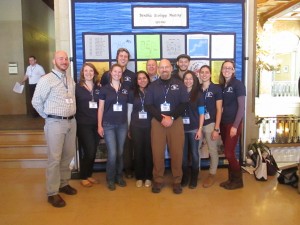
Amber Stubler, Rebecca Kulp, Elizabeth Gomez, and Stephen Heck had oral presentations showing the variety of work being currently done by students at the Peterson Lab. Brad Peterson presented some last summer’s seagrass work he did with last summer with two of his students Lisa Jackson and Brad Furman. Diana Chin, Amanda Tinoco, and Niko Floros presented posters with their work at the Peterson Lab. And John Carroll (2012 PhD alumni!) presented his work done in Jamaica during the annual winter class.
The Peterson Lab also had a strong showing in the dance floor, as usual, joining in with other groups including the Heck Lab from Dauphin Island Sea Lab. Other fun activities included ice skating, dog sledding, and enjoying the local cuisine.
The following work as presented at Benthics:
Posters
Chin, D.W.; Peterson, B.J.Investigating a potential mutualism between Solemya velum and Zostera marina mediated by symbiotic sulfide-oxidizing bacteria
Furman, B.T.; Tinoco, A.I.; and Peterson, B.J. SAV, topography and flow characteristics in the Upper, Tidal Hudson River: Progress toward a predictive habitat model
Floros, N.J.; Kulp, R.E.; and Peterson, B.J.Investigating how habitat density can alter intraspecific competition in mesopredators.
Oral Talks
Peterson, B.J.; Jackson, L.J.; and Furman, B.T. The plant-animal interactions our mamma warned you about: suspension-feeding bivalves effecting Zostera marina reproductive growth spurs.
Stubler, A.; Furman, B.; and Peterson, B. Sponge erosion under acidification and warming scenarios: differential impacts on living and dead coral.
Gomez, E.; Peterson, B.; Borrett, S.; and La Peyre, M. A dynamic ecological model using oyster reef bioenergetics to measure and predict secondary production.
Kulp, R.E.; Petraitils, P.S.; and Peterson, B.J. Comparing functional responses of a mesopredator across a habitat density gradient.
Heck, S.M.; Boyce, P.B.; Coughlan, K.A.; Schenck, F.R.; Hughes, A.R.; and Grabowski, J. Effects of habitat complexity on bay scallop population dynamics in Nantucket Harbor.
Carroll, J.M.; Stubler, A.D.; Peterson, B.J.; and Finelli, C.M. Is the grass always greener on the other side? A tale of two herbivory studies from Discovery Bay, Jamaica.
On the week of December 8-12, 2014, our lab member Elizabeth Gomez attended the 2014 A Community on Ecosystem Services Conference in Washington D.C. after being selected as a student fellow.
Liz presented her work on oyster reef bioenergetics models linked to an ecosystem services framework during an oral talk. The conference was a success and an excellent opportunity for feedback from different disciplines.
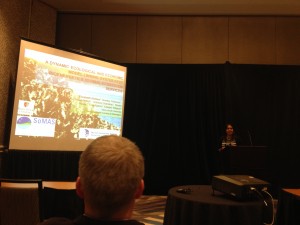
Liz won a Student Fellowship to attend the conference and was awarded a recognition certificate.
Peterson Lab…extending its domain world wide.
Welcome to the new Peterson Lab Website.
Here you will find everything about the research at the Marine Community Ecology Lab and any news of our members.
We invite you to check out the site, read about all the awesome research we are doing, and get the latest news about our lab.
November 3rd marked the beginning of Scallop Season in Long Island and the Peterson Lab braved the frigid waters for a tasty dinner cooked by Amber Stubler!
